Do-it-yourself vertical wind generator: how to assemble a wind turbine with a vertical axis of rotation
The wind has incredible energy capabilities. The failure to use its powerful potential should be safely recognized as unreasonable waste. But you can easily build a vertical wind generator with your own hands and receive virtually free energy to cover domestic needs. This is quite real, agree?
The presented article will help to understand in detail a complex technical issue. Systematized, accessible information presented in great detail illuminates the principle of operation of popular systems that process the energy of air masses into electricity.
Without a doubt, you will be carried away by the idea of creating a windmill, the specifics of the assembly of which are described in the article. We examined in detail different types of vertical wind generators, touched on their differences, advantages and disadvantages. The text part of the material is perfectly complemented by photos and video instructions.
The content of the article:
Advantages and principle of operation of windmills
Modern vertical generator - one of the options alternative energy for home. The unit is able to convert wind gusts into an energy resource. For correct operation, it does not need additional devices that determine the direction of the wind.

The vertical type device operates at low altitude.For its maintenance, various devices are not needed that ensure the safe conduct of high-altitude repair and maintenance work.
A minimum of moving parts makes the wind turbine more reliable and operationally stable. The optimal profile of the blades and the original shape of the rotor provide the unit with a high level of efficiency, regardless of the direction in which the wind blows at any given moment.
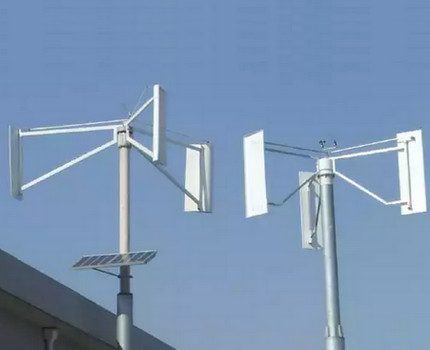
The generator works absolutely silently, does not interfere with the owners and neighbors, does not create harmful emissions into the atmosphere and serves reliably for many years, accurately supplying energy to residential premises.
The vertical wind-driven generator operates on the principle of magnetic levitation. During the rotation of the turbines, pulsed and lifting forces are generated, as well as the actual braking force. The first two rotate the blades of the unit. This action activates the rotor and it creates a magnetic field that generates electricity.
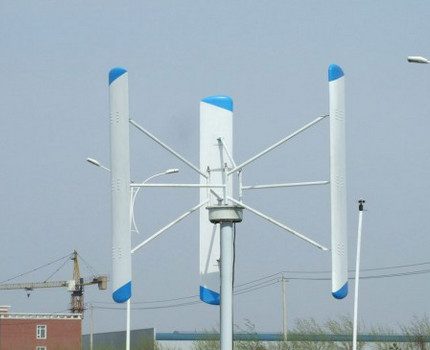
The device operates completely independently and does not require host intervention in the process.
Vertical Generator Classification
There is some structural difference between the vertical type wind-traps. It does not make the units better or worse, but simply allows you to choose the most convenient option for performing specific tasks in a particular area.
# 1: Features of orthogonal systems
Structurally, the orthogonal wind generator consists of a strong axis of vertical rotation and several parallel blades remote from the center base at a certain distance.
The device does not need additional guiding mechanisms and works normally, regardless of the direction of the wind. A vertically located main shaft makes it possible to place the drive equipment at ground level, which greatly facilitates the operation, repair and maintenance.
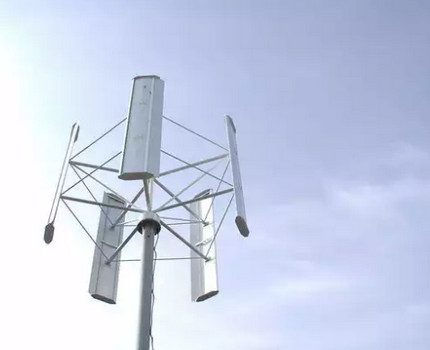
The disadvantages of orthogonal devices include a too massive blade system and low efficiency compared to the efficiency of horizontal axis modules.
The simplest wind turbine for powering low-power consumers can be assembled from finished components:
# 2: Daria Rotor Generators
A wind generator equipped with a Darier rotor has a vertical axis of rotation and 2-3 flat strip-blades without a characteristic aerodynamic profile, fixed at the base and at the top of the axis of rotation.
The unit in its work does not focus on the strength or direction of the wind, has a high rotation speed and allows the location of the drive devices on the ground, which facilitates and accelerates the process of scheduled maintenance and possible repairs.
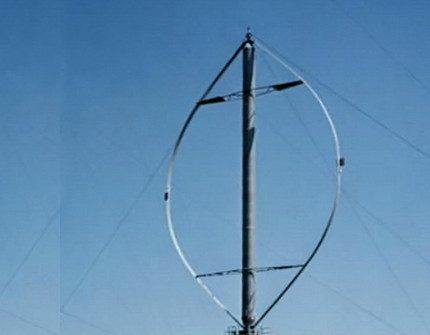
The supporting and rotating components of the device with the Darier rotor are vulnerable to increased dynamic loads, and the efficiency of the blade system is inferior in many respects to axial horizontal installations.
# 3: Savonius Rotor Units
A vertical wind turbine with a Savonius rotor has a semi-cylindrical blade system and differs from similar installations in high starting torque and the ability to work effectively in low-speed winds.
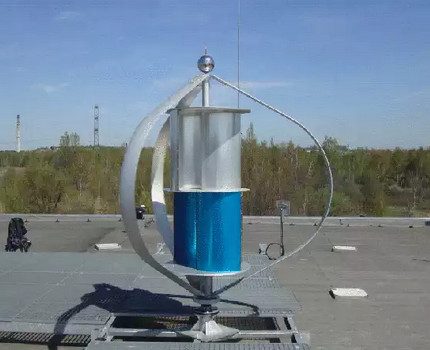
The vertical complex with the Savonius rotor is reproached with increased material consumption and lower efficiency in comparison with horizontal-axis wind generators. That is why the release of high-power equipment of this class is considered not advisable.
The following photo selection will familiarize you with the steps of making a Savonius windmill:
All details of this model of a Savonius windmill except for a generator at 3200 rpm and 24 V are made by hand.
# 4: Wind turbine with multi-vane rotor and guide
This type of instrument is an improved version of the classic orthogonal wind generator. The rotor complex here consists of blades arranged in two rows.
The outer lobed layer remains static and acts as a guide vane. It captures the wind stream, captures it, compresses it and in this way significantly increases the actual wind speed.
The inner row of blades is a movable structure, on which the air flow from the first rotary installation falls at a certain angle.
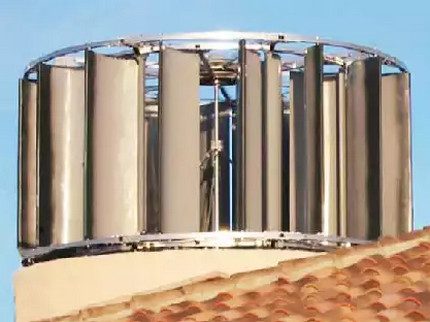
Experts call this type of device the most efficient in its class and emphasize that the specific design allows it to work even at the lowest possible wind speeds.
# 5: Characterization of devices with a helicoid rotor
Helicoid wind turbine or Gorlov generator is another modification of the traditional orthogonal rotor system. The blades of the model are twisted in an arc. This design feature makes it possible to quickly catch the air flow and rotate smoothly without jerking.
This principle of operation significantly reduces the dynamic load on the base and movable nodes, thereby increasing their service life.
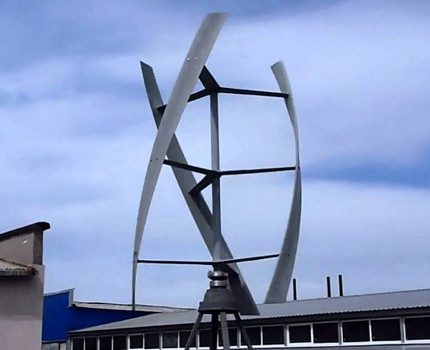
The swirling rotor blades for a helicoid windmill are made using a very progressive, but complex technology. Because of this, the units have a fairly high cost and are not widely popular among private consumers.
# 6: Characteristics of vertical axis rotors
The main difference between a vertically axial generator is its vertically positioned blades, reminiscent of an aircraft wing in profile, whose axis is clearly parallel to the vertical shaft. The design is somewhat reminiscent of the Darier rotor, but in production conditions it is made much faster and easier.
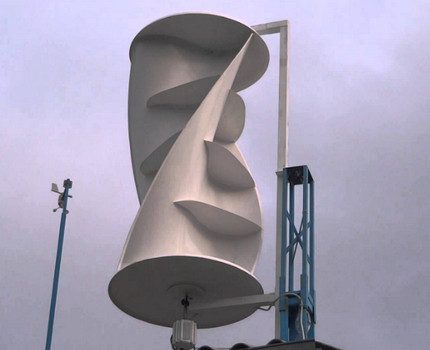
Wind turbines with a rotor of a vertical-axial type are reliable and durable, easily withstand significant operational loads and do not cost too much money. These qualities make them relevant for use not only in industrial but also for domestic purposes.
Features of the choice of wind generators for a private house and an overview of the best offers are presented in this article.
Hand made windmill
To create a wind generator with a vertical axis of rotation at home with your own hands is not too difficult. It is enough to purchase the required component parts, assemble them in the correct order and install the module in the selected place. As soon as the minimum breeze appears, the product will work and begin to give the owners the necessary energy.
Step 1: Procurement of components and materials
To make a vertical wind generator with your own hands, you need such components:
- rotor - movable part of the unit:
- the blades - parts that capture the wind flow;
- axial mast - for fastening the rotor and blades (may take the form of a long pole, pyramid or tripod);
- stator - Intended for placement of a coil with a durable copper wire;
- battery - capacious capacity for accumulating the received resource;
- inverter - a device for converting direct current to alternating current;
- controller - the device braking the generator, at the moment the unit develops the actual power that exceeds the baseline.
For the manufacture of blades suitable light quality sheet plastic with a good indicator of elasticity. Other types of materials are too susceptible to various damage and deformation and simply can not cope with such a high dynamic load.
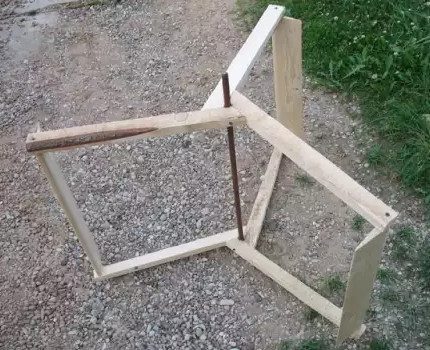
Small blades can be made of medium density PVC, and for large, wide parts you will need the most durable material that can withstand strong winds blowing at a speed of 15 m / s and higher for a long time.
Step 2: Preparing Elements
For creating blades 4 vertical parts are cut out of a vertical wind generator from a high-strength PVC pipe. Two semicircular fragments are cut out of tin and fixed on each side of the pipe. The radius of rotation of the blade parts in this case will be 690 mm, and the height of each blade will be about 700 mm.
To assemble the rotor system, neodymium magnets (6 pcs), ferrite disks with a diameter of 230 mm (2 pcs) and glue are taken. Magnets are placed on the first disk, alternating in polarity and observing an angle of 60 degrees between them with a diameter of 165 mm. The second disc is made in the same way, and then the magnets are filled with glue.
For the stator, 9 coils are prepared and 60 turns of copper wire with a diameter of 1 mm are wound on each of them.
Subsequent adhesion occurs in the following order:
- beginning of 1 coil with end 4;
- start 4 with end 7 of the coil.
The second phase is collected according to the same principle, but they begin to work with 2 coils, and the third with 3 coils. A special shape is made from a plywood sheet, the bottom is lined with a piece of fiberglass and phases soldered from coils are placed on top.
Fill the structure with glue and leave for 1-2 days, so that all the details are seized and take the right places. Then they proceed to join the individual parts into a single working system.
Step 3: Assembling All Generator Parts
To connect all the generator elements in the upper rotor, 4 holes for the studs are made. The lower rotor is placed magnets up on the bracket. Next, the stator is placed, after making holes in it for attaching to the bracket.
The studs rest on the aluminum plate and then cover with a second rotor, placing it with magnets down.
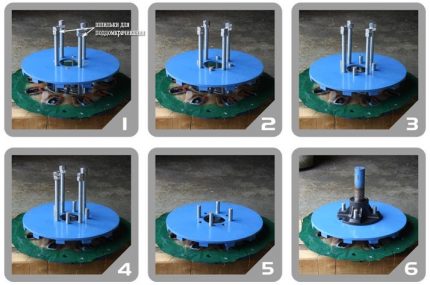
Using a wrench, the studs are rotated alternately so that the upper rotor descends to the lower rotor evenly and without jerking. When it takes its place, the studs are twisted and the aluminum plates are removed. At the end, the whole structure is fixed with nuts and tighten them clearly, but not too tight so as not to break the thread.
Step 4: Final Hardware Installation
For the mast, they take a strong metal pipe 4-5 meters long and screw the generator already assembled with it to the screw. Then they attach the frame with plastic blades to the generator and install the mast structure on a prepared site with a three-point reinforced foundation.
Additionally, the position of the system is fixed with a stretch.
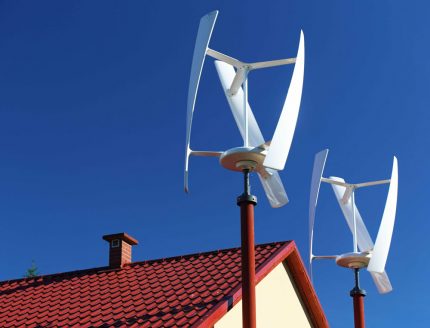
The electric network to the windmill is connected in a certain sequence. The controller receives a resource from the generator and converts the alternating current into direct current, which is necessary to charge the battery. Can assemble the controller yourself according to a simplified scheme.
The battery accumulates the released energy, and the inverter turns the direct current into alternating current, which feeds the bulk of household appliances and home service systems.
On our site there is a selection of articles on the home-made manufacture of various types of wind generators.
We advise you to familiarize yourself with:
- Do-it-yourself wind generator from a washing machine: assembly instructions for a windmill
- DIY wind generator from a car generator: windmill assembly technology and error analysis
- How to make a wind generator with your own hands: device, principle of operation + best home-made
Another interesting option for the construction of a vertical windmill can be assembled from waste materials, spending no more than 250 rubles on the purchase of additional components. Independent craftsmen will need a bicycle wheel, another 12 bicycle spokes, an axis from the rear bicycle wheel with three nuts, a steel strip, 11 aluminum plates.
Still need 150 rivets, M4 bolts with nuts in the amount of 18 pieces, M6 bolts with nuts in the amount of 3 pieces, 27 larger washers and 24 small ones.
In brief, the following gallery will demonstrate assembly steps:
The following video tutorial will present all the steps in detail:
Choosing a place for a wind generator
Choosing the right place to install the wind generator is an important step. It is best to place the device on an open maximum point and carefully monitor that it does not fall below the level of adjacent residential and farm buildings. Otherwise, the buildings will become an obstacle to the air flow and the efficiency of the unit will greatly decrease.
If the site goes to a river or lake, the windmill is placed on the shore, where the winds blow especially often. Perfectly located for the location of the generator elevations available in the territory, or large empty spaces that do not have artificial or natural barriers to air flow.
When residential real estate (house, cottage, apartment, etc.) is located in the city or located outside the city, but in places of dense development, the wind power complex is put on the roof.
To place the generator on the roof of an apartment building, they take the written consent of the neighbors and receive official permission from the relevant authorities.
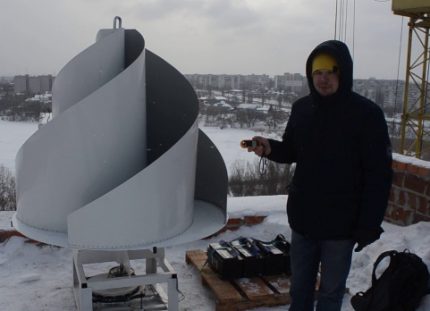
In a private house with a large garden, choosing a suitable place is much easier. The main thing to consider is that the structure is located at a distance of 15-25 meters from the living quarters. Then the sound effects from the rotating blades will not bother anyone.
Upright Maintenance
In order for the vertical wind generator to work efficiently, clearly and as efficiently as possible, all moving parts of the structure must be lubricated. Such a procedure is carried out at least 2 times for the entire calendar year.
At the same time, during maintenance, tighten the nuts loose during operation, strengthen the electrical connections, check the mechanical components for corrosion, tighten the loose tension cables and carefully inspect the blades for rupture or damage.
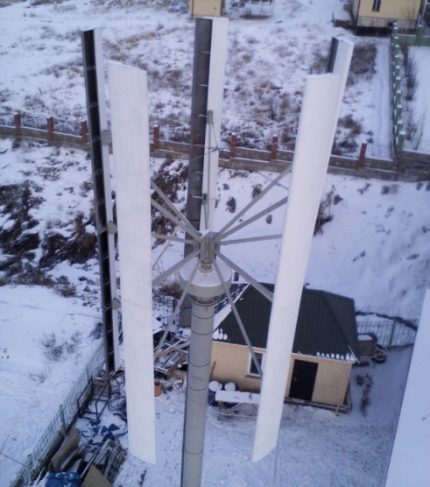
Parts are painted as needed and, once a year, they perform a complete examination of the entire structure for malfunctions. Such care ensures the correct operation of the wind turbine and extends its operational period.
Assessment of the feasibility of installation
Before proceeding with the manufacture of a vertical type wind generator, they study the weather situation in their region and try to determine whether the unit can provide the necessary amount of resource.
Experts recommend evaluating the following parameters:
- number of windy days - take the average value for the year when the gust exceeds 3 m / s;
- volume of electricityconsumed per day by home ownership;
- appropriate place in a private area for wind equipment.
The first indicator is learned from data obtained at the nearest weather station or found on the Internet at the respective portals. Additionally, they are checked with printed geographical publications and make up a complete picture of the situation with the wind in their region.
Statistics are taken not in one year, but in 15-20 years, only then the average figures will be as correct as possible and show whether the generator can fully satisfy the household’s need for electricity or if it’s enough power only to supply individual household needs.
If the owner has at his disposal a large plot of land located on a slope, near the riverbank or in an open space, there will be no problems with installation.
When the house is located in the depths of the village, and the yard is compact in size and closely adjacent to the neighboring buildings, installing a vertical model of a wind turbine with your own hands will not be easy. The structure will have to be raised 3-5 meters above the ground and additionally strengthened so that it does not fall with a strong rush.
All this information needs to be taken into account at the planning stage, so that it becomes clear whether the wind generator will be able to take on full energy supply or whether its role will remain within the framework of the auxiliary energy source. It is preferable to conduct windmill calculation.
Conclusions and useful video on the topic
Video No. 1 demonstrates how to make a vertical wind generator with a Darier rotary system with your own hands at home. The video illustrates the features and curious nuances of the assembly process. There is a definition of the maximum power of the manufactured unit:
How the vertical wind generator works and to what extent it generates energy, video # 2 will show. It provides a detailed overview of the module and a description of the work on the correct measurement of actual power and other parameters:
Video 3 shows testing a makeshift vertical-type wind generator. What is a device made by hand made from improvised materials capable of:
Such a modern and practical source of alternative energy as vertical windmills is easy to assemble with your own hands. With proper business experience, each part can be manufactured and then all components combined into a single, integral design.
If you don’t want to complicate the task, it is quite appropriate to purchase ready-made components at home, without rushing and fuss, to mount a reliable wind turbine that can ensure uninterrupted supply of electricity to the living room.
When in your abilities there is no absolute certainty, it is better to entrust the work to professionals. They will do everything very quickly and in full compliance with basic operational requirements.
Have experience building and operating a wind generator? Please share information with our readers, suggest your way of assembling the unit. You can leave comments and add homemade photos in the form below.

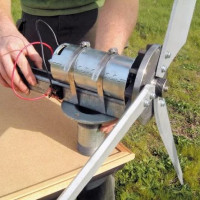 Do-it-yourself wind generator from a washing machine: assembly instructions for a windmill
Do-it-yourself wind generator from a washing machine: assembly instructions for a windmill 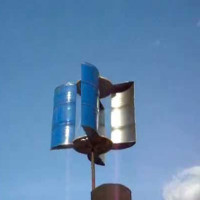 DIY wind generator from a car generator: windmill assembly technology and error analysis
DIY wind generator from a car generator: windmill assembly technology and error analysis 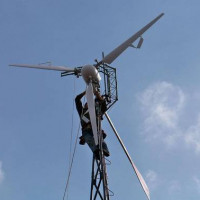 How to make a wind generator with your own hands: device, principle of operation + best home-made
How to make a wind generator with your own hands: device, principle of operation + best home-made 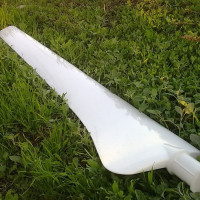 How to build do-it-yourself blades for a wind generator: examples of self-made blades for a wind turbine
How to build do-it-yourself blades for a wind generator: examples of self-made blades for a wind turbine  How to make a controller for a wind generator with your own hands: device, principle of operation, assembly diagram
How to make a controller for a wind generator with your own hands: device, principle of operation, assembly diagram  Wind generator for a private house: device, types, overview of the best offers
Wind generator for a private house: device, types, overview of the best offers  How much does it cost to connect gas to a private house: the price of organizing gas supply
How much does it cost to connect gas to a private house: the price of organizing gas supply  The best washing machines with dryer: model rating and customer tips
The best washing machines with dryer: model rating and customer tips  What is the color temperature of light and the nuances of choosing the temperature of the lamps to suit your needs
What is the color temperature of light and the nuances of choosing the temperature of the lamps to suit your needs  Replacement of a geyser in an apartment: replacement paperwork + basic norms and requirements
Replacement of a geyser in an apartment: replacement paperwork + basic norms and requirements
Some advanced households have long been using wind power to provide their household with the necessary energy. To get rid of utility bills, and more out of curiosity, I assembled a wind turbine with my own hands. I needed a rotor, plastic blades, a mast (it's on a tripod), a battery and a controller. In the process of rotation of the turbines and blades, 2 lifting and electric forces are formed. The blades spin, the rotor is activated and electricity is generated.
Well, and how are the results? Is there any exhaust from it? I myself have long had a desire to try to assemble a wind generator in the country. Of course, as a main source of energy, I do not hope for it. While I consider it more as a pampering and an interesting experience, but then what the hell is not joking. Another thing is that I have not progressed much further than ideas. Little by little I collect the details - I have already found normal blades and I know where to get a long mast. This summer, of course, I will not have time, but next year I will try to more actively engage in the windmill right from the spring.
Well what can I say? Vertical wind generators are not a promising direction in the long term. Yes, such a design is easier to assemble, but on an industrial scale such wind generators practically do not use. Why? Here are a few highlights:
- The entire surface of the surface of the blades is not used (1/3 is activated by the wind, 1/3 is resistive, 1/3 is not involved);
- you need a long shaft to transmit torque;
- Low output power.
But to begin with, such designs are quite suitable to start at least with something. At the same time, vertical wind generators have their advantages:
- There is no need to “catch the wind” (strong winds are not terrible and there is no need for collectors);
- The cost of the project;
- Ease of maintenance.
But in the future it is better to focus on the classic design of wind generators.
In the description of the manufacture of the generator the ratio of magnets and coils is incorrectly indicated! For 9 coils, 12 pairs of magnets (24 pcs.) Are needed. Maybe that’s why the result on the video is deplorable.